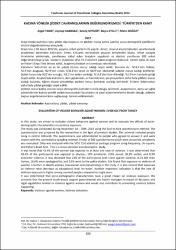| dc.contributor.author | Yanık, Aygül | |
| dc.contributor.author | Hanbaba, Zeynep | |
| dc.contributor.author | Soygür, Sevinç | |
| dc.contributor.author | Ayaltı, Büşra | |
| dc.contributor.author | Doğan, Meral | |
| dc.date.accessioned | 2021-12-12T22:01:02Z | |
| dc.date.available | 2021-12-12T22:01:02Z | |
| dc.date.issued | 2014 | |
| dc.identifier.issn | 2146-7684 | |
| dc.identifier.issn | 2146-7684 | |
| dc.identifier.uri | https://doi.org/10.17339/ejovoc.49520 | |
| dc.identifier.uri | https://dergipark.org.tr/tr/pub/ejovoc/issue/5396/73203 | |
| dc.identifier.uri | https://dergipark.org.tr/tr/download/article-file/62660 | |
| dc.identifier.uri | https://hdl.handle.net/20.500.11857/3956 | |
| dc.description | DergiPark: 73203 | en_US |
| dc.description | ejovoc | en_US |
| dc.description.abstract | In this study, we aimed to evaluate violent behaviors against women and to evaluate the effects of sociodemographic characteristics on violence exposure. The study was conducted during November 1st - 30th, 2012 using the face-to-face questionnaire method. The questionnaire was prepared by the researchers in the light of previous studies. The universe included people living in central Kirklareli. The questionnaire was administered to people who agreed to answer it and were chosen with the conveniency sampling method. A total of 900 questionnaires which were answered completely was evaluated. Data was analyzed with the SPSS 15.0 statistical package program using frequency, chi-square, and Fisher's Exact Test. This is a croos-sectional and descriptive study. It was found that 43.4% of the women was exposed to at least one type of violence. It was determined that 18.4% of the participants was exposed to physical, 13% emotional, 2.9% sexual, 30.2% verbal, and 8.9% economic violence. It was observed that 22% of the participants kept silent against violence, 8.2% left their homes, 16.6% were apologized to, and 2.9% went to the police station. It is found that exposure to violence of women is further in elderly women, housewives and nonworkings in the study. It is also noticed that exposure to violence rates decrease as educational level increases. Another important indication is that the rate of violence exposure is higher among married people compared to single ones. It was determined that socio-demographic characteristics have a great impact on violence exposure. We presume that the present study would support governmental and health managers in means of decisions and legal regulations related to violence against women and would also contribute to preventing violence before happening | en_US |
| dc.description.abstract | Araştırmada kadınlara karşı şiddet davranışlarını ve şiddete maruz kalma üzerine sosyo-demografik özelliklerin etkisini değerlendirmeyi amaçladık.Araştırma 1-30 Kasım 2012’de, yüzyüze anket yöntemi ile yapıldı. Anket, mevcut araştırmalardan yararlanılarak araştırmacı tarafından hazırlandı. Evren, Kırklareli merkezinde yaşayan bireylerden oluştu. Anket kolayda örnekleme yöntemiyle, yanıtlamayı kabul eden bireylere uygulandı ve eksiksiz yanıtlanan 900 anket değerlendirmeye alındı. Verilerin analizinde SPSS 15.0 istatistik paket programı kullanıldı. Veriler sıklık, Ki-Kare ve Fisher’s Exact Test ile test edildi. Araştırma kesitsel ve tanımlayıcı niteliktedir.Kadınların %43.4’nün en az bir şiddet türüne maruz kaldığı tespit edildi. Bunların da %18.4’nün fiziksel, %13’nün duygusal, %2.9’nun cinsel, %30.2’nin sözel ve %8.9’nun ekonomik şiddete maruz kaldığı belirlendi. Şiddet karşısında %22’nin sustuğu, %8.2’nin evden ayrıldığı, %16.6’dan özür dilendiği, %2.9’nun karakola gittiği tespit edildi. Araştırmada kadınların, ileri yaştakilerin, ev hanımlarının, çalışmayanların daha fazla şiddete maruz kaldığı bulundu. Eğitim düzeyi yükseldikçe şiddete maruz kalmanın azaldığı belirlendi. Evlilerin bekarlardan daha fazla şiddet gördüğü tespit edildi.Şiddete maruz kalma üzerine sosyo-demografik özelliklerin etkili olduğu belirlendi. Araştırmanın, kamu ve sağlık yöneticilerinin kadına yönelik şiddet konusundaki kararlarına ve yasal düzenlemelerine destek olacağı, şiddetin baştan engellemesine katkı sağlayacağı tahmin edilmektedir. | en_US |
| dc.language.iso | tur | en_US |
| dc.publisher | Kırklareli Üniversitesi | en_US |
| dc.relation.ispartof | Ejovoc (Electronic Journal of Vocational Colleges) | en_US |
| dc.identifier.doi | 10.17339/ejovoc.49520 | |
| dc.rights | info:eu-repo/semantics/openAccess | en_US |
| dc.subject | Violence against women | en_US |
| dc.subject | violence behaviors | en_US |
| dc.subject | Kadına karşı şiddet | en_US |
| dc.subject | şiddet davranışı | en_US |
| dc.title | KADINA YÖNELİK ŞİDDET DAVRANIŞLARININ DEĞERLENDİRİLMESİ: TÜRKİYE’DEN KANIT | en_US |
| dc.type | article | |
| dc.department | Meslek Yüksekokulları, Sağlık Hizmetleri Meslek Yüksekokulu, Çocuk Bakımı ve Gençlik Hizmetleri Bölümü | |
| dc.identifier.volume | 4 | en_US |
| dc.identifier.startpage | 104 | en_US |
| dc.identifier.issue | 4 | en_US |
| dc.identifier.endpage | 111 | en_US |
| dc.relation.publicationcategory | Makale - Ulusal Hakemli Dergi - Başka Kurum Yazarı | en_US |



















